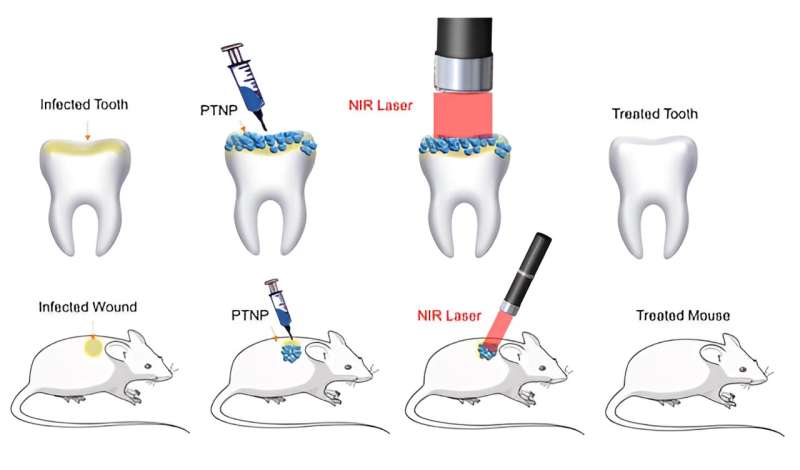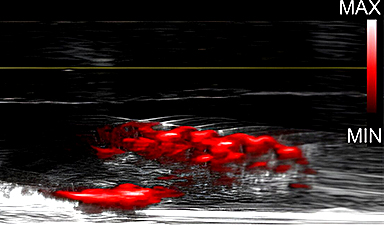If left to their own devices, bacteria on our teeth or wounded skin can encase themselves in a slimy scaffolding, turning into what is called biofilm. These bacteria wreak havoc on our tissue and, being shielded from antibiotic medication by the slime, are difficult to dislodge. A new strategy may offer a simple way to break up the muck and destroy the bacteria.
Researchers at the University of Pennsylvania and Stanford University have developed sugar-coated gold nanoparticles that they used to both image and destroy biofilms. In a study published in the Journal of Clinical Investigation, the authors demonstrated the diagnostic and therapeutic potential of the nanoparticles on the teeth and wounded skin of rats and mice, eliminating the biofilms in as little as one minute and outperforming common antimicrobials.
“With this platform, you can bust biofilms without surgically debriding infections, which can be necessary when using antibiotics. Plus, this method could treat patients if they are allergic to antibiotics or are infected by strains that are resistant to medication,” said Luisa Russell, Ph.D., a program director in the Division of Discovery Science & Technology at NIBIB. “The fact that this method is antibiotic-free is a huge strength.”
Oral biofilms, also known as plaques, formed by bacteria such as Streptococcus mutans can cause significant tooth decay. Wound infections, which are commonly caused by Staphylococcus bacteria, can greatly delay the healing process. In either case, the densely packed network of proteins and carbohydrates within biofilms can prevent antibiotics from reaching microbes throughout the affected area.
But that isn’t the extent of the issue posed by biofilms. Not only are they difficult to remove, but they are troublesome to discern in the first place.
This new research identified a solution to knock out both problems with one stone: gold.
Gold is nontoxic and readily converts energy from light sources into heat, making it a prime candidate for photothermal therapy, a strategy that utilizes the heat from nanoparticles to kill nearby pathogens. In addition to generating heat, the nanoparticles emit detectable ultrasound waves in response to light, meaning that gold particles can be visualized using a technique called photoacoustic imaging.
In the new study, the authors encapsulated gold spheres within larger golden cage-shaped nanoparticles to optimize their response to light for both therapeutic and imaging purposes. To make the particles appealing to bacteria, they coated them in dextran, a carbohydrate that is a common building block of biofilms.

with near infrared lasers to destroy biofilms. Credit: Hajfathalian, et al.
The researchers assessed their strategy by applying the gold nanoparticles atop S. mutans-infected teeth from ex vivo rat jaws.
In a photoacoustic imaging test on the teeth, the nanoparticles emitted signals that came through loud and clear, allowing the team to see precisely where biofilms had taken up the dextran-coated particles on the teeth.
Then, to evaluate the particles’ therapeutic effect, they irradiated the teeth with a laser. For comparison, they treated other infected teeth samples with the topical antiseptic chlorhexidine.
The team observed a stark contrast in the outcomes of the two treatments, with the photothermal therapy being nearly 100% effective at killing biofilms, while chlorhexidine did not significantly diminish the viability of bacteria.
“The treatment method is especially fast for the oral infection. We applied the laser for one minute, but really in about 30 seconds we’re killing basically all of the bacteria,” said study first author Maryam Hajfathalian, Ph.D., a professor of biomedical engineering at the New Jersey Institute of Technology, who conducted this study while a postdoctoral researcher at both the University of Pennsylvania and Stanford University.
Evaluations conducted on mice with open wounds in their skin, infected with Staphylococcus aureus, were similarly successful, as heat generated by nanoparticles greatly outperformed another antimicrobial agent called gentamicin. Here, the researchers also measured and noted a rise in temperature of 20°C localized to the biofilm, not causing any apparent damage to surrounding tissue.
The authors indicate that with further tests they aim to show whether the strategy can prevent cavities or speed up healing.
“I think it’s important to see how inexpensive, straightforward, and fast this process is. Since we are limited in using antibiotics, we need novel treatments like this as a replacement,” Hajfathalian said.
More information: Maryam Hajfathalian et al, Theranostic gold-in-gold cage nanoparticles enable photothermal ablation and photoacoustic imaging in biofilm-associated infection models, Journal of Clinical Investigation (2023). DOI: 10.1172/JCI168485
Provided by National Institutes of Health
News
Cell Membranes May Act Like Tiny Power Generators
Living cells may generate electricity through the natural motion of their membranes. These fast electrical signals could play a role in how cells communicate and sense their surroundings. Scientists have proposed a new theoretical [...]
This Viral RNA Structure Could Lead to a Universal Antiviral Drug
Researchers identify a shared RNA-protein interaction that could lead to broad-spectrum antiviral treatments for enteroviruses. A new study from the University of Maryland, Baltimore County (UMBC), published in Nature Communications, explains how enteroviruses begin reproducing [...]
New study suggests a way to rejuvenate the immune system
Stimulating the liver to produce some of the signals of the thymus can reverse age-related declines in T-cell populations and enhance response to vaccination. As people age, their immune system function declines. T cell [...]
Nerve Damage Can Disrupt Immunity Across the Entire Body
A single nerve injury can quietly reshape the immune system across the entire body. Preclinical research from McGill University suggests that nerve injuries may lead to long-lasting changes in the immune system, and these [...]
Fake Science Is Growing Faster Than Legitimate Research, New Study Warns
New research reveals organized networks linking paper mills, intermediaries, and compromised academic journals Organized scientific fraud is becoming increasingly common, ranging from fabricated research to the buying and selling of authorship and citations, according [...]
Scientists Unlock a New Way to Hear the Brain’s Hidden Language
Scientists can finally hear the brain’s quietest messages—unlocking the hidden code behind how neurons think, decide, and remember. Scientists have created a new protein that can capture the incoming chemical signals received by brain [...]
Does being infected or vaccinated first influence COVID-19 immunity?
A new study analyzing the immune response to COVID-19 in a Catalan cohort of health workers sheds light on an important question: does it matter whether a person was first infected or first vaccinated? [...]
We May Never Know if AI Is Conscious, Says Cambridge Philosopher
As claims about conscious AI grow louder, a Cambridge philosopher argues that we lack the evidence to know whether machines can truly be conscious, let alone morally significant. A philosopher at the University of [...]
AI Helped Scientists Stop a Virus With One Tiny Change
Using AI, researchers identified one tiny molecular interaction that viruses need to infect cells. Disrupting it stopped the virus before infection could begin. Washington State University scientists have uncovered a method to interfere with a key [...]
Deadly Hospital Fungus May Finally Have a Weakness
A deadly, drug-resistant hospital fungus may finally have a weakness—and scientists think they’ve found it. Researchers have identified a genetic process that could open the door to new treatments for a dangerous fungal infection [...]
Fever-Proof Bird Flu Variant Could Fuel the Next Pandemic
Bird flu viruses present a significant risk to humans because they can continue replicating at temperatures higher than a typical fever. Fever is one of the body’s main tools for slowing or stopping viral [...]
What could the future of nanoscience look like?
Society has a lot to thank for nanoscience. From improved health monitoring to reducing the size of electronics, scientists’ ability to delve deeper and better understand chemistry at the nanoscale has opened up numerous [...]
Scientists Melt Cancer’s Hidden “Power Hubs” and Stop Tumor Growth
Researchers discovered that in a rare kidney cancer, RNA builds droplet-like hubs that act as growth control centers inside tumor cells. By engineering a molecular switch to dissolve these hubs, they were able to halt cancer [...]
Platelet-inspired nanoparticles could improve treatment of inflammatory diseases
Scientists have developed platelet-inspired nanoparticles that deliver anti-inflammatory drugs directly to brain-computer interface implants, doubling their effectiveness. Scientists have found a way to improve the performance of brain-computer interface (BCI) electrodes by delivering anti-inflammatory drugs directly [...]
After 150 years, a new chapter in cancer therapy is finally beginning
For decades, researchers have been looking for ways to destroy cancer cells in a targeted manner without further weakening the body. But for many patients whose immune system is severely impaired by chemotherapy or radiation, [...]
Older chemical libraries show promise for fighting resistant strains of COVID-19 virus
SARS‑CoV‑2, the virus that causes COVID-19, continues to mutate, with some newer strains becoming less responsive to current antiviral treatments like Paxlovid. Now, University of California San Diego scientists and an international team of [...]





















